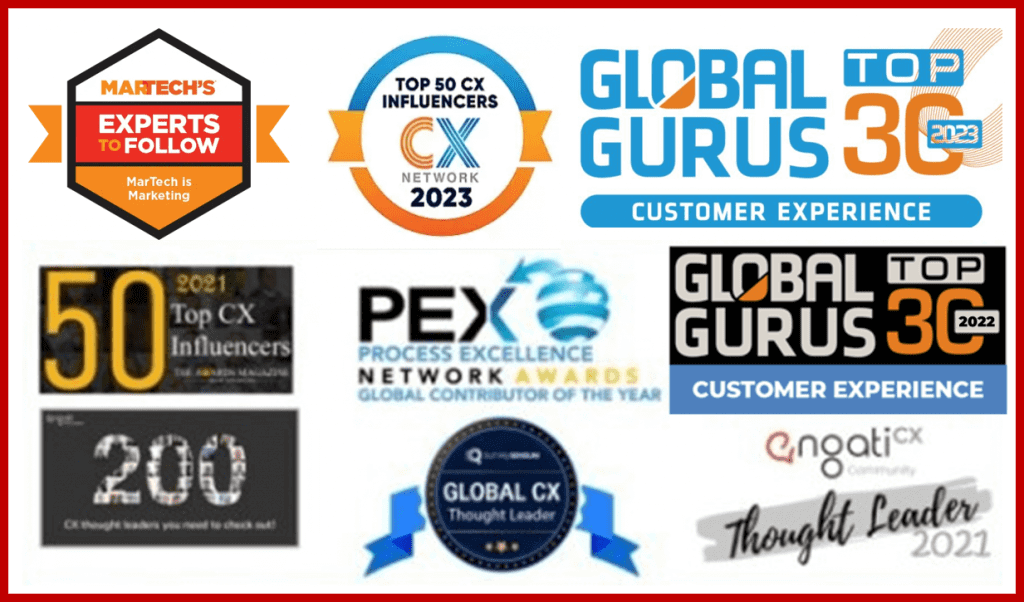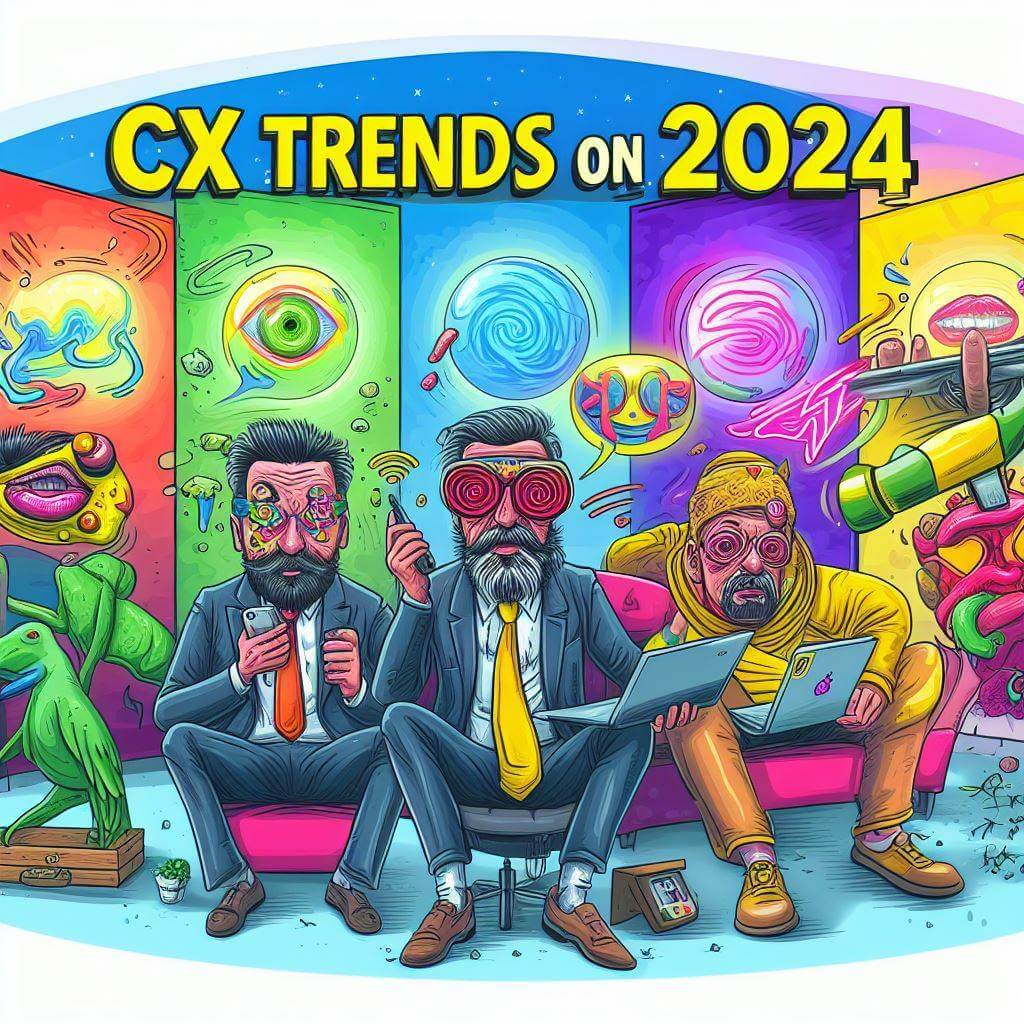This article explores the five customer experience trends in 2024 that businesses need to monitor.
As we look towards 2024 and beyond, the customer experience (CX) landscape continues to evolve rapidly.
To stay ahead in today’s highly competitive market, businesses must embrace emerging CX trends and make them an integral part of their strategy.

Five CX Trends influencing your path in 2024
Key Takeaways:
- CX is a critical factor in today’s competitive landscape.
- Designing memorable CX experiences is crucial for driving customer satisfaction and loyalty.
- Effective CX management can drive business success.
- Leveraging CX metrics can provide valuable insights for decision-making.
- Personalization, omnichannel CX, AI, automation, emotional CX, and customer feedback are all key trends that businesses need to embrace.
- CX done well, will win the Triple Crown (simultaneously improving satisfaction, growing revenues and reducing costs)
The Importance of CX Strategy
A well-defined CX strategy is crucial for businesses to thrive in today’s competitive landscape. CX strategy encompasses the framework and processes put in place to ensure that every customer interaction is meaningful, valuable, and delivers a consistent experience across all touchpoints. The ultimate goal is to increase customer satisfaction and loyalty, which in turn wins the Triple Crown and drives business success.
Having a solid CX strategy can differentiate your brand from competitors and turn customers into loyal advocates. It involves understanding your customers’ needs, pain points, and preferences and aligning your business objectives to meet them. By doing so, you are more likely to retain customers, increase revenue, and gain a competitive advantage.
The Importance of CX Strategy
“A customer’s interactions with a brand should be seamless, personalized, and consistent across all channels. A well-executed CX strategy is essential to achieving this and driving customer satisfaction and loyalty.”
Designing Memorable CX Experiences
Creating memorable customer experiences is essential for any business looking to stay ahead in today’s competitive landscape. To achieve this, CX design and user experience (UX) play a key role in crafting delightful interactions that leave a lasting impression on customers.
The Key Elements of CX Design
Successful CX design involves a deep understanding of the customer’s needs, wants, and preferences. By putting yourself in the customer’s shoes, you can identify pain points and opportunities for improvement in the customer experience.
Here are some essential elements of CX design:
- Clear and intuitive navigation
- Consistent branding and messaging
- Engaging visuals and multimedia
- Personalization and customization
- Easy access to customer support
By incorporating these elements into your CX design, you can create a seamless and enjoyable experience for your customers.
Why UX is Key to CX
User experience (UX) is a vital component of CX design, as it focuses on the usability and functionality of digital interfaces. A well-designed UX can enhance the overall customer experience and drive customer satisfaction.
Here are some ways that UX can improve CX:
- Reduced friction in the customer journey
- Clear and concise communication
- Efficient and effective task completion
- Seamless integration across devices and platforms
By prioritizing UX in your CX design, you can create a consistent and positive experience for your customers across all touchpoints.
“Good design is good business.” – Thomas J. Watson Jr.
As Thomas J. Watson Jr. famously stated, good design is essential for business success. Incorporating CX design and UX principles into your business strategy can create memorable and enjoyable experiences that drive customer satisfaction and loyalty.
The Role of CX Management
CX management is vital in ensuring that businesses deliver a seamless customer experience and boost customer satisfaction. Effective CX management involves understanding customer needs, analyzing customer feedback, and utilizing the right tools and techniques to optimize their experience.
There are several key components of CX management, including:
- CX strategy: A solid CX strategy aligns with business goals and objectives and provides a framework for delivering a consistent and positive customer experience. It involves identifying customer pain points, mapping out customer journeys, and defining customer personas.
- CX measurement: To ensure that CX management efforts are effective, businesses must track and analyze customer feedback and behaviour. This involves leveraging CX metrics such as Customer Experience Six (CX6), Customer Effort Score (CES), Customer Satisfaction (CSAT) and Net Promoter Score (NPS). .
- CX design: CX design plays a crucial role in crafting memorable interactions that leave a lasting impression on customers. It involves optimizing touchpoints across the customer journey, creating user-friendly interfaces, and delivering personalized experiences.
- CX technology: CX technology, such as customer relationship management (CRM) systems and chatbots can streamline processes and enhance customer interactions, leading to improved satisfaction and loyalty.
By investing in CX management, businesses can boost customer satisfaction, increase revenue, and gain a competitive advantage in the market.
Leveraging CX Metrics for Success
Measuring and analyzing CX metrics is crucial for gauging the success of your customer experience initiatives. By leveraging the right metrics, you can make data-driven decisions to optimize the customer experience and drive customer satisfaction and loyalty.
The Metrics that Matter
Not all CX metrics are created equal, and focusing on the ones that matter most is important. Here are some key metrics to consider:
| Metric | Description |
| Customer Experience Six[1] (CX6) | Measures the potential areas to improve in the Customer Experience |
| Net Promoter Score (NPS) | Measures the likelihood that a customer would recommend your brand to others. |
| Customer Satisfaction Score (CSAT) | Measures how satisfied customers are with a specific experience, such as a purchase or interaction with customer support. |
| Customer Effort Score (CES) | Measures how easy or difficult it was for customers to complete a specific task or interact with your brand. |
| Churn Rate | Measures the percentage of customers who discontinue doing business with your brand over a certain period. |
Tracking these metrics regularly can help you identify areas for improvement and measure the impact of any changes made to the customer experience.
Leveraging CX Metrics
Once you have identified the metrics that matter most, it’s important to use them to drive continuous improvement in the customer experience. Here are some tips:
- Set goals: Use your metrics to set achievable goals for improving the customer experience. For example, aim to improve your CX6 rating by 15% over the next quarter.
- Act on feedback: Use Real-time customer feedback collected through listening across channels to make meaningful ‘in the moment’ changes to the customer experience.
- Track progress: Monitor your metrics regularly to track progress towards your goals and identify any areas that need further improvement.
By leveraging CX metrics effectively, you can drive continuous improvement in the customer experience and increase customer satisfaction and loyalty.
The Power of Personalization in CX
One of the most significant trends in CX optimization is the power of personalization. Customers today expect personalized experiences that cater to their unique needs and preferences. In fact, according to a study conducted by Epsilon, 80% of customers are more likely to do business with a company that offers personalized experiences.
To achieve this level of personalization, businesses need to gather and analyze customer data. This includes demographic information, purchase history, and customer feedback. By leveraging this data, businesses can create tailored recommendations, customized experiences, and personalized interactions that resonate with customers.
Personalization can also be achieved through dynamic content. This involves showing different content to different users based on their interests, preferences, and behaviours. For example, an e-commerce website can display product recommendations based on a user’s browsing and purchase history.
Examples of Personalization in CX
Here are a few examples of how businesses are using personalization to enhance the customer experience:
| Company | Personalization Strategy | Result |
| Amazon | Product recommendations based on browsing and purchase history | 35% of Amazon’s revenue comes from personalized recommendations |
| Netflix | Customized content recommendations based on viewing history | Personalized recommendations account for 80% of what people watch on Netflix |
| Starbucks | Personalized mobile app that remembers customer preferences | Mobile orders account for 22% of Starbucks’ sales |
As these examples show, personalization can have a significant impact on CX optimization. By personalizing the customer experience, businesses can increase customer satisfaction, loyalty, and revenue.
The Rise of Omnichannel CX
The traditional customer experience has evolved to encompass multiple touchpoints, including online, offline, mobile, social media, and more. As a result, businesses must adapt to meet customers’ needs and provide a seamless omnichannel experience.
Providing a consistent brand experience across all channels is essential for CX optimization and customer satisfaction. Omnichannel experiences enable businesses to build stronger relationships with their customers by providing them with the flexibility to interact with the brand on their preferred channels.
Personalization is key to achieving a successful omnichannel experience. Customers expect businesses to provide tailored interactions and recommendations based on their preferences and behaviour. Businesses can deliver personalized experiences that drive engagement and loyalty by leveraging customer data and insights.
The Role of AI and Automation in CX Optimization
Artificial intelligence (AI) and automation are revolutionizing the customer experience landscape. From chatbots and virtual assistants to predictive analytics and machine learning algorithms, businesses are leveraging AI and automation to optimize CX and enhance customer satisfaction.
One of the significant advantages of AI and automation in CX is the ability to streamline processes and reduce customer effort. For instance, chatbots can provide immediate assistance and resolve common queries, reducing wait times and increasing the speed of service delivery. Furthermore, predictive analytics can help identify customer issues before they occur and enable proactive interventions to minimize the impact on customer satisfaction.
Another critical aspect of AI and automation in CX is personalization. By analyzing customer data and behavior patterns, businesses can provide personalized recommendations and tailored experiences that meet individual needs and preferences. For example, Netflix’s recommendation engine uses machine learning to suggest content based on user viewing habits, increasing engagement and customer satisfaction.
The Benefits of AI and Automation in CX Optimization
The table below summarizes some of the key benefits of using AI and automation in CX optimization:
| Benefits of AI and Automation in CX Optimization | Examples |
| Streamline processes and reduce customer effort | Chatbots, virtual assistants, self-service portals |
| Identify and resolve customer issues proactively | Predictive analytics, machine learning algorithms |
| Deliver personalized experiences | Recommendation engines, personalized messaging |
| Improve customer engagement and loyalty | Virtual assistants, chatbots, AI-powered customer service |
As the capabilities of AI and automation continue to evolve, businesses that embrace these technologies are poised to gain a competitive advantage in CX optimization. By leveraging data-driven insights and personalized experiences, businesses can drive customer satisfaction, loyalty, and ultimately, business success.
The Role of Emotional CX
When it comes to optimizing the customer experience, tapping into your customers’ emotions can be a game-changer. Businesses can significantly enhance customer satisfaction and loyalty by creating emotionally impactful interactions.
A study by Forrester found that companies that excel at emotional CX outperform their competitors by 26% in revenue growth. One way to create emotional connections with customers is through personalized experiences that cater to their unique interests and preferences.
Another way to tap into emotions is by leveraging storytelling. By telling stories that resonate with customers on a personal level, businesses can create a deeper emotional connection that goes beyond transactions and fosters long-term loyalty.
“People will forget what you said, people will forget what you did, but people will never forget how you made them feel.” – Maya Angelou.
In addition to personalized experiences and storytelling, it’s important to remember that empathy plays a crucial role in emotional CX. By understanding and empathizing with your customers’ needs and pain points, businesses can create a more positive and empathetic experience that shows they care.
Overall, emotional CX is a critical component of optimizing the customer experience. Businesses can enhance customer satisfaction and foster long-term loyalty by creating emotionally impactful interactions through personalization, storytelling, and empathy.
The Importance of listening to every interaction for Continuous CX Optimization
Establishing listening posts is a crucial component in the ongoing effort to optimize the customer experience (CX). To improve CX, it is important to collect and analyze Real-Time customer interactions, identify areas for improvement, and make ‘in the moment’ changes.
Traditional feedback is expensive and only provides a retrospective view of CX. It is like driving a car by only looking in the rear-view mirror (potentially with disastrous consequences). Proactively listening and building a rich, actionable capability to introduce improvements immediately is a key differentiator.
Using CX Metrics for Continuous Innovation
| Metric | Description | How to Use It |
| Customer Experience Six (CX6) | Measures the CX across six elements: How, Fast, Easy, Convenient, Trackable, Personalized and Predictive | Identify areas for improvement and track changes over time |
| Customer Effort Score (CES) | Measures how easy it is for customers to complete a specific task | Identify friction points and streamline the customer journey |
| Customer Satisfaction (CSAT) | Measures overall satisfaction with a specific interaction or experience | Pinpoint areas for improvement and track changes in satisfaction over time |
Using effective CX metrics enables businesses to track performance and identify areas for improvement. It is important to establish a baseline and set goals in order to measure success and understand the impact of changes made based on customer feedback.
Acting on Customer Feedback
Collating RealTime feedback is only the first step. It is important to act on the information ‘in the moment’ and make necessary changes to improve the customer experience. Here are a few steps businesses can take to act on customer feedback:
- Establish listening posts at every customer interaction
- Implement ‘action in the moment’ capabilities
- Enable individuals and teams at the listening posts to make decisions and execute changes immediately
- Share feedback with relevant teams and stakeholders
- Prioritize feedback based on frequency and impact
- Create an action plan to integrate the learning and changes
- Communicate changes made based on feedback to customers
- Track and measure the impact of changes made
By listening intently at every interaction across the customer experience, businesses can continuously improve the CX and ensure customer satisfaction, lower costs and higher revenues.
In conclusion, gathering and acting on customer feedback is essential for continuous CX optimization. By listening through various channels, using effective CX metrics, and acting on the data, businesses can improve the customer experience and drive customer satisfaction.
Conclusion
As we look towards 2024 and beyond, it is clear that the customer experience will be a crucial element of any successful business strategy. By staying ahead of emerging CX trends, businesses can optimize their customer interactions and drive satisfaction and loyalty.
The Importance of a Well-Defined CX Strategy
A well-defined CX strategy is crucial for businesses looking to stand out in a competitive landscape. By prioritizing the customer experience, businesses can enhance customer satisfaction and loyalty, ultimately driving success.
Designing Memorable CX Experiences
The key to memorable customer experiences lies in smart CX design. By leveraging UX principles and prioritizing customer needs, businesses can create interactions that leave a lasting impression and drive loyalty.
The Power of CX Management
Expertly managing the customer experience can turn satisfied customers into loyal brand advocates. By utilizing the right tools and techniques, businesses can optimize their CX strategy and drive success.
Leveraging CX Metrics for Success
The right CX metrics can provide valuable insights into the effectiveness of customer experience initiatives. By measuring and analyzing these metrics, businesses can make data-driven decisions to optimize their strategy and enhance customer satisfaction.
The Importance of Personalization in CX
Personalization is key to optimizing the customer experience in today’s landscape. By tailoring interactions to customer preferences and needs, businesses can stand out and create lasting relationships with their customers.
The Rise of Omnichannel CX
Providing a seamless omnichannel experience is becoming increasingly important for businesses looking to drive satisfaction and loyalty. By integrating various touchpoints, businesses can enhance the customer journey and drive success.
The Role of AI and Automation in CX
Artificial intelligence and automation are transforming the customer experience landscape. By leveraging these technologies, businesses can streamline processes and enhance interactions, ultimately driving satisfaction and loyalty.
The Importance of Emotional CX
Emotions play a key role in the customer experience. By tapping into emotions and creating positive interactions, businesses can drive satisfaction and loyalty, ultimately driving success.
Customer Feedback for Continuous Improvement
Gathering and acting on customer feedback is crucial for businesses looking to improve their CX strategy continuously. By listening to their customers and making meaningful changes, businesses can optimize the customer experience and drive success.
By staying ahead of emerging CX trends and prioritizing the customer experience, businesses can drive success in 2024 and beyond.
FAQ
What are the top five customer experience trends in 2024 and beyond?
The top five customer experience trends in 2024 and beyond are: CX strategy, CX design, CX management, CX metrics, and personalization in CX.
Why is having a well-defined CX strategy important?
Having a well-defined CX strategy is crucial because it can lead to increased customer satisfaction and loyalty.
What are the key elements of designing memorable customer experiences?
The key elements of designing memorable customer experiences are user experience (UX) and CX design.
How does CX management drive business success?
CX management drives business success by effectively managing the customer experience and optimizing customer satisfaction.
Why is measuring CX metrics important?
Measuring CX metrics is important to gauge the success of customer experience initiatives and make data-driven decisions.
How does personalization impact the customer experience?
Personalization significantly impacts the customer experience by creating tailored interactions and customized experiences.
What is the importance of providing an omnichannel customer experience?
Providing a seamless omnichannel customer experience is important as it drives customer satisfaction and loyalty.
How does AI and automation transform the customer experience landscape?
AI and automation transform the customer experience landscape by streamlining processes and enhancing customer interactions.
How do emotions impact the customer experience?
Emotions play a significant role in the customer experience and tapping into emotions can create positive interactions that drive satisfaction and loyalty.
Why is listening at every interaction important for continuous improvement?
Establishing listening posts is important for continuous innovation as it helps businesses gather insights and make meaningful changes to enhance the customer experience.
Resources
The BPG’s CEMMethod provides a framework to implement a practical and immediate improvement to both operational and strategic CX.
Review these resources for more:
Accredited Customer Experience Professional® (ACXP®) training: https://experienceprofessional.com/acxm_inviterce5167p

CEMMethod v.15: https://cemmethod.net
CX Resources: https://www.bpgroup.org
CX Measurement: The CX6 overview: https://youtu.be/i7p_d9d7yrg?si=4yg1kAtefJlcq4BE
[1] CX6 – overview video
if you pay people for doing dumb stuff,
Steve Towers
they’ll get really smart at it.
Meet Steve Towers

Steve Towers, Chief Experience Officer for the BPG, an expert in customer experience, enjoys spreading his enthusiasm for this field through coaching, consultancy, keynote speeches and books.
He helps companies win the triple crown – the simultaneous ability to increase revenues, decrease costs, and enhance service – through the CEMMethod, which is now in version 15.
With over three decades of experience working with large enterprises worldwide, Steve has distilled the successful strategies of top-performing organizations into a proprietary methodology that can be easily imparted to CX teams and executives.
His forte lies in envisioning the future of customer-centricity, customer experience, process management and realizing long-term benefits from business transformation. Steve’s approach combines customer-focused thinking, cutting-edge technologies, and a human touch.
Steve is also an entrepreneur and an early-stage investor in software companies like Parallel.
Subscribe to this channel and reach out and connect with Steve via https://linktr.ee/stevetowers


